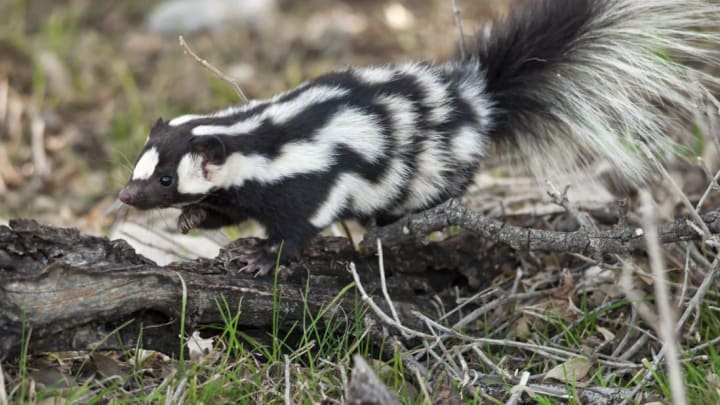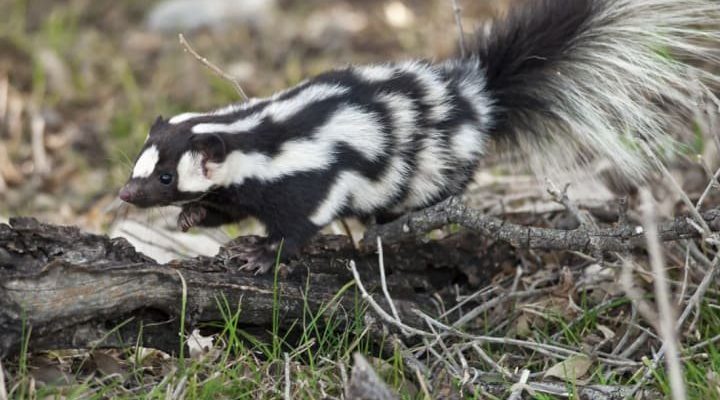
Picture skunks as survivors in a world filled with challenges. Much like how humans have adapted over time, skunks have developed unique features and behaviors to navigate their surroundings. Let’s dive into the evolutionary history of these intriguing animals to see how they became the critters we know today.
Early Ancestors of Skunks
Skunks belong to the family Mephitidae, and their roots trace back to a group of small carnivorous mammals known as carnivorans. These mammals first emerged around 56 million years ago. Imagine a time when the planet looked completely different—there were no modern-day skunks; instead, their ancestors scurried around in ancient forests alongside other early mammals.
These early carnivorans began to diverge into different groups. Some adapted to their environments and developed traits that would lead to what we now recognize as skunks. Their evolutionary journey was not a straight line; instead, it resembled a branching tree, with each branch representing a different adaptation to life in varied habitats.
One critical adaptation was their diet. Originally, these ancestors were primarily carnivorous, hunting smaller prey. However, as they evolved, they became opportunistic feeders. This flexibility allowed them to thrive in different environments, from forests to grasslands.
The Rise of Modern Skunks
Fast forward to about 10 million years ago, and the modern skunk started to emerge. They split into distinct groups, evolving into the different species we know today. The most recognized member of the skunk family is the striped skunk, famous for its bold warning coloration and that infamous scent.
Here’s the thing: this scent isn’t just for show. It’s an essential survival mechanism. When threatened, skunks can spray a noxious fluid from their anal glands to deter predators. This ability likely evolved as a defense strategy, helping them survive against larger carnivores. You might even say it’s like having a built-in security system!
The uniqueness of skunks doesn’t stop at their scent. Their physical appearance, with striking black and white patterns, likely evolved as a form of warning coloration. Many animals use bright colors or patterns to signal danger or to show they are toxic. So, by looking intimidating with their striking appearance, skunks help themselves stay safe.
Skunk Habitats and Distribution
Skunks are incredibly adaptable animals, which has played a huge role in their evolutionary success. You can find them in diverse habitats, from urban areas to forests and meadows. Their ability to thrive in different environments stems from their flexible diet and intelligent foraging strategies.
In urban settings, skunks can be found rummaging through trash cans or looking for food in gardens. They’ve learned to take advantage of human activity, making them quite common in suburban areas. This ability to adapt their behavior to new challenges shows just how resilient skunks can be.
Their range extends throughout North America, with some species even venturing into South America. This broad distribution highlights their evolutionary success. They can live in areas with varying climates and conditions, from the cold northern regions to warmer southern climates.
Behavioral Adaptations
Aside from their scent, skunks have developed several fascinating behavioral adaptations over time. One of these is their exceptional ability to dig. Skunks dig for food, hunting insects, grubs, and even small mammals underground. Their strong forelimbs and sharp claws make them excellent diggers, allowing them to access hidden food sources.
Their social behavior is another interesting aspect. While many think of skunks as solitary animals, some species actually exhibit social structures. For example, young skunks often stay with their mothers for several months, learning essential survival skills. This behavior increases their chances of survival as they learn where to find food and how to evade predators.
You might be wondering how they communicate. Skunks use a variety of vocalizations and body language to express themselves. From hissing to growling, their sounds can signal alarm or serve as a warning to other skunks.
The Importance of Skunks in Their Ecosystem
Skunks are often overlooked in discussions about wildlife, but they play a vital role in their ecosystems. As omnivores, they help control insect populations by feasting on pests like beetles and grubs. This natural pest control is essential for maintaining a balanced ecosystem and promoting healthy plant growth.
Their foraging habits also assist in seed dispersal. When skunks eat fruits and nuts, they often help spread seeds through their droppings. This process encourages plant growth and contributes to the overall health of their habitats.
Interestingly, skunks also fall prey to larger mammals, such as coyotes and owls. This predator-prey relationship is crucial for maintaining population balance in the ecosystem. So, while skunks might seem like mere scavengers, they are an integral part of a much larger environmental puzzle.
Conservation Status and Challenges
Despite their evolutionary success, skunks face various challenges today. Habitat loss due to urban development and agricultural expansion puts pressure on skunk populations. As their natural environments shrink, their ability to adapt may be tested.
Additionally, skunks are often misunderstood. Many people fear them due to their smell and consider them pests. This negative perception can lead to inhumane treatment and even unnecessary killings. Education about skunks is vital to counter these misconceptions and promote coexistence.
Conservation efforts focusing on preserving habitats and educating communities can help ensure skunk populations remain healthy. Their role in the ecosystem highlights the need for all species, no matter how seemingly minor, to be respected and valued.
The Future of Skunks
As we look to the future, skunks will continue to adapt to changing environments. Their ability to thrive in urban settings showcases their resilience, but it also raises concerns. Urbanization might offer new challenges, like increased human-wildlife conflicts and road hazards.
Conservationists and wildlife organizations are working hard to monitor skunk populations and implement strategies to promote their well-being. This includes initiatives like habitat restoration and public education campaigns.
Ultimately, understanding the evolutionary history of the skunk helps us appreciate these unique creatures. By respecting their role in the ecosystem and advocating for their protection, we can help ensure that skunks continue to thrive for generations to come.
In summary, skunks are much more than their smell. They’re survivors with a rich evolutionary history, adaptable behavior, and a crucial role in their ecosystems. As we learn more about them, we can better appreciate the delicate balance of nature that includes these fascinating animals.

